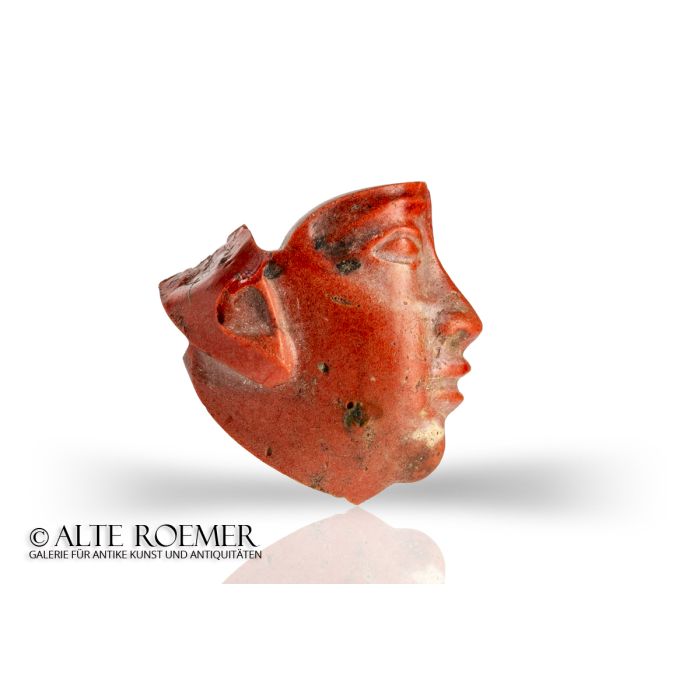Egyptian glass inlay in face shape
€8,900
available
Object number
AR3472
| Object: |
Egyptian glass inlay in face shape
|
| Material: |
Red glass paste.
|
| Period: |
Ptolemaic period of Ancient Egypt, 332 BC to 30 BC. In literature such inlays are sometimes dated earlier, to the 30th Dynasty from 379 BC, or to the early Roman period, to the 1st century AD. |
| Description: |
Flat relief made of opaque red glass paste in the shape of a face. With carved ears, eyes, eyebrows, nose and mouth and a smooth surface. The back is flat.
The piece served as an inlay and decorative element. It was combined with a headgear and a body.
|
| Dimensions: |
28mm x 28mm. 12mm thick.
|
| Condition: |
Great condition. The surface is smooth and the details are perfectly preserved. Old chipping to the edge of the ear. The few small chips and deposits on the surface are probably ancient. Some dark discolourations are probably not paint residues but caused by storage in the ground. Overall, an impressive example of fine Egyptian craftsmanship.
|
| Provenance: |
Acquired by us in 2023 on the British art market. Previously in a British private collection. Acquired into the collection at Christie's London auction 3 July 2018, lot 29. Consigned from the French Altounian family estate, acquired by Joseph Altounian (1889-1954). For the very similar glass inlay in the Joseph Altounian collection, with collection number 1297, but made of blue glass paste, an acquisition in 1921 from the Arthur Sambon collection is noted. It is not certain, but it can be speculated that the sister piece here made of red glass paste was also acquired in 1921 from the French Arthur Sambon collection. The Parisian archaeologist Dr. Arthur Sambon (1867-1947) traded with art objects from his private collection. His father, Giulio Sambon (1836-1921), had already traded coins and art objects on a larger scale in Italy. Joseph Altounian was a well-known art dealer who opened his gallery in Paris in 1906. Together with his wife Henriette Lorbet, he moved the business to Mâcon in 1924. Egyptian and Greek artefacts were a focus of the shop, which soon counted renowned museums in Europe and the USA among its customers. In 1954, the next generation took over the business, so that the Altounian's inventory and private collection remained in the family. |
| References: |
Cf. H. W. Müller, Ägyptische Kunstwerke, Kleinfunde und Glas, p. 132, A188c. Cf. E. M. Stern und B. Schlick-Nolte, Early Glass of the Ancient World, p. 342, no. 106. Cf. S. M. Goldstein, Pre-Roman and Early Roman Glass in The Corning Museum of Glass, p. 169, no. 447. For a very similar inlay on the art market see Sotheby's London auction of 3 July 2020, lot 69 (estimated at 20,000 GBP to 30,000 GPB, equivalent at the time to approximately 22,000 EUR to 33,000 EUR). |
| Authenticity: |
We unconditionally guarantee the authenticity of every artefact, all items are subject to our lifetime return policy on authenticity.
|


